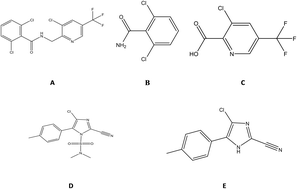Our official English website, www.x-mol.net, welcomes your
feedback! (Note: you will need to create a separate account there.)
Residue and risk assessment of fluopicolide and cyazofamid in grapes and soil using LC-MS/MS and modified QuEChERS
RSC Advances ( IF 3.9 ) Pub Date : 2018-10-16 00:00:00 , DOI: 10.1039/c8ra06956e Tianheng Xu 1 , Xiaoxiao Feng 1 , Lixiang Pan 1 , Jing Jing 1 , Hongyan Zhang 1
RSC Advances ( IF 3.9 ) Pub Date : 2018-10-16 00:00:00 , DOI: 10.1039/c8ra06956e Tianheng Xu 1 , Xiaoxiao Feng 1 , Lixiang Pan 1 , Jing Jing 1 , Hongyan Zhang 1
Affiliation

|
The residue behavior of fluopicolide, cyazofamid and their metabolites (M-01, M-02 and CCIM) was evaluated in open field conditions. The dissipation and terminal residue of these five compounds were determined via a modified QuEChERS method, by adjusting the liquid chromatography coupled with tandem mass spectrometry (LC-MS/MS) conditions and optimizing the purification process. This led to a satisfactory average recovery of between 71.6% and 107.7%, as well as limit of quantitation (LOQ) values of 0.05 mg kg−1. The dissipation results recorded in two places in China illustrated that the half-life values of fluopicolide are 11.4 (Anhui, grape), 19.7 (Anhui, soil) and 21.8 (Hebei, grape), 21.2 (Hebei, soil) days, respectively. As for the dissipation of cyazofamid, it was found to have half-life values of 8.7 (Anhui, grape) and 20.1 (Hebei, grape) days. The final residues in grapes were found to be below the maximum residue limit (MRL) of 2 mg kg−1 for fluopicolide and 1 mg kg−1 for cyazofamid. Thus, a preharvest interval of 10 days and recommended MRLs from the Joint FAO/WHO Meeting on Pesticide Residues (JMPR) are appropriate to ensure the food safety of fluopicolide and cyazofamid in grapes. The hazard quotient (HQ) and acute hazard index (aHI) values were found to be below 100%, demonstrating negligible risk in consuming grapes, regardless of long or short-term exposure.
中文翻译:

使用 LC-MS/MS 和改进的 QuEChERS 对葡萄和土壤中氟吡内酯和氰唑菌胺的残留和风险评估
在露天条件下评估了氟哌啶醇、氰唑菌胺及其代谢物(M-01、M-02 和 CCIM)的残留行为。通过改进的 QuEChERS 方法,通过调整液相色谱与串联质谱 (LC-MS/MS) 条件并优化纯化过程,确定这五种化合物的消散和末端残留物。这导致令人满意的平均回收率在 71.6% 和 107.7% 之间,以及 0.05 mg kg -1的定量限 (LOQ) 值. 我国两地记录的耗散结果表明,氟吡内酯的半衰期值分别为11.4(安徽,葡萄)、19.7(安徽,土壤)和21.8(河北,葡萄)、21.2(河北,土壤)天。至于氰唑胺的消散,发现其半衰期值为8.7(安徽,葡萄)和20.1(河北,葡萄)天。发现葡萄中的最终残留量低于氟哌啶醇的最大残留限量 (MRL) 2 mg kg -1和 1 mg kg -1用于氰唑胺。因此,10 天的采前间隔和粮农组织/世界卫生组织农药残留联合会议 (JMPR) 推荐的最大残留限量是适当的,以确保葡萄中氟哌啶虫内酯和氰唑胺的食品安全。发现危害商 (HQ) 和急性危害指数 (aHI) 值低于 100%,表明无论长期或短期接触,食用葡萄的风险都可以忽略不计。
更新日期:2018-10-16
中文翻译:

使用 LC-MS/MS 和改进的 QuEChERS 对葡萄和土壤中氟吡内酯和氰唑菌胺的残留和风险评估
在露天条件下评估了氟哌啶醇、氰唑菌胺及其代谢物(M-01、M-02 和 CCIM)的残留行为。通过改进的 QuEChERS 方法,通过调整液相色谱与串联质谱 (LC-MS/MS) 条件并优化纯化过程,确定这五种化合物的消散和末端残留物。这导致令人满意的平均回收率在 71.6% 和 107.7% 之间,以及 0.05 mg kg -1的定量限 (LOQ) 值. 我国两地记录的耗散结果表明,氟吡内酯的半衰期值分别为11.4(安徽,葡萄)、19.7(安徽,土壤)和21.8(河北,葡萄)、21.2(河北,土壤)天。至于氰唑胺的消散,发现其半衰期值为8.7(安徽,葡萄)和20.1(河北,葡萄)天。发现葡萄中的最终残留量低于氟哌啶醇的最大残留限量 (MRL) 2 mg kg -1和 1 mg kg -1用于氰唑胺。因此,10 天的采前间隔和粮农组织/世界卫生组织农药残留联合会议 (JMPR) 推荐的最大残留限量是适当的,以确保葡萄中氟哌啶虫内酯和氰唑胺的食品安全。发现危害商 (HQ) 和急性危害指数 (aHI) 值低于 100%,表明无论长期或短期接触,食用葡萄的风险都可以忽略不计。











































 京公网安备 11010802027423号
京公网安备 11010802027423号